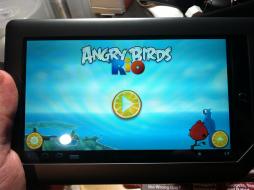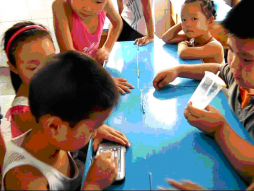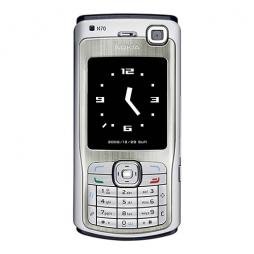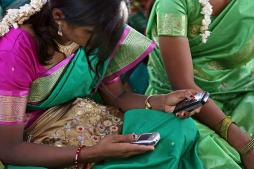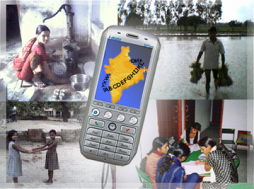literacy
Posted by LindsayEllen on Sep 30, 2011
Grassroots Support Organizations and Capacity-Building in M4D: A Case Study of the Jokko Initiative in Senegal data sheet 1108 Views
Abstract:
Fueled by renewed enthusiasm about the potential of new information and communication technologies (ICTs) for development, non-governmental organizations (NGOs) are implementing ambitious projects with mobile technology components in the developing world in a phenomenon commonly referred to as “Mobiles-for-development” or “M4D.”
A participatory approach that responds to the needs and realities of local communities is widely recognized as a necessary component of a successful M4D intervention. However, project failure-especially in sub-Saharan Africa- remains the norm, pointing towards the need for more thorough enumeration of best practices and more rigorous impact evaluation on the part of field-based practitioners. This thesis calls for greater attention to be given to the role of human capacity, which is a precondition for participation in M4D interventions but which also tends to be deficient in rural, poor communities. A greater focus on capacity would entail both assessing capacity- in terms of physical resources and human capabilities- at the local level and including capacity-building in project activities when necessary.
This study employs the human development and capabilities approach and the case study and participant observation methods to examine the efforts of the American NGO Tostan to integrate mobile technology into its non-formal education and empowerment program in rural Senegal. The findings of this study underscore the decisive role played by local capacity and intent and by effective, locally based intermediary organizations, conceptualized in this paper as grassroots support organizations (GSOs), that support the acquisition of the human capabilities needed to harness the empowering potential of mobile technology and other ICTs.
Posted by AnneryanHeatwole on Jul 22, 2011
As mobile gaming explodes worldwide, the market for “games for good” (either with an educational or social-change focus) is open for growth. Mobile games provide a way to quickly pass time, an always-on-hand source of entertainment, and a way to connect with others through competing scores or sharing strategies. Can mobile games also be used to teach, inform, and raise awareness?
Level One: The Mobile Gaming Landscape
The current mobile landscape shows that games are popular worldwide, regardless of handset type or region. A June 2011 Gartner report on the state of the gaming industry reported that mobile gaming is expected to see the largest growth percentage of any aspect of the industry (compared to consoles and PCs), estimating “its share growing from 15 percent in 2010 to 20 percent in 2015.” Tuong Nguyen, principal research analyst at Gartner, is quoted as saying, “As the popularity of smartphones and tablets continues to expand, gaming will remain a key component in the use of these devices. Although [mobile devices] are never used primarily for gaming, mobile games are the most downloaded application category across most application stores, […] For this reason, mobile gaming will continue to thrive as more consumers expand their use of new and innovative portable connected devices.”
The growth of mobile games can be clearly seen in US mobile trends; a July 2011 report from Nielsen says that games are the most popular kind of app for smartphone owners, with 64% of US smartphone owners using a mobile game app at least once a month. The Nielsen report also found that “the average mobile gamer plays an average of 7.8 hours a month,” and that “those with iPhones tend to play around 14.7 hours each month while those with Android smartphones play around 9.3 hours per month.”
But mobile games aren’t just popular on smartphones; feature phone users are embracing the mobile gaming trend as well. MobiThinking’s 2011 global mobile statistic report found that among Africans who use mobile devices as their primary means of accessing the Internet, 55 percent report downloading games. OnDevice Research’s 2011 Mobile Internet Satisfaction report found that mobile games can influence handset purchase, as users want mobile devices that can support games. They report that, “89% of mobile media users in Kenya consider the quality of games they can play on their device when choosing a new phone.”
A 2009 report on India’s mobile gaming field from Vital Analytics found “approximately 120 million urban Indians used their mobile phones to play games during quarter ending July 2009, a reach of 41%. In terms of time spent playing games, 37% of the population spends less than an hour in a week playing games while on the other end of the spectrum 9% spend over 5 hours on an average.” The report also found that most popular types of mobiles games for Indian users were sports games (such as cricket) and arcade-style puzzle games.
With all these mobile gaming enthusiasts out there, where does that leave educational and social change games? Couldn’t some of this popularity be turned toward math, literacy, or advocacy games? The landscape shows that mobile games are popular regardless of handset and location, so the question now is how to make a game that provides both value and entertainment to the player.
Posted by VivianOnano on Jun 09, 2011
Study on Potentials of Mobile Phones in Investment and Development Projects data sheet 1402 Views
Abstract:
This report draws on the experiences of projects using mobile phone-based information and communication technologies (ICT) applications in a number of situations, including mobile monitoring and evaluation, m-banking, community development, literacy, anti-corruption, agricultural extension and agricultural value chain information and access.
The report begins with a general overview of the role that mobile phone-based ICT can play in development and commercial projects, focusing on the situations in which mobile phonebased applications are particularly appropriate, on the potential impacts that they can achieve and on their comparative advantages vis-a-vis other forms of mobile ICT.
The report then considers in more detail the experience of the projects in using mobile phone-based ICT, shedding light on such issues as the appropriateness and relevance of the systems used, their replicability and scalability and their sustainability.
Posted by MarkWeingarten on Feb 10, 2011
The field of mLearning, or learning facilitated by mobile devices, has been generating growing interest in recent years and months. Outspoken advocates of mLearning, such as the authors of a report recently released by GSMA Development Fund, assert that the increasing ubiquity of mobile phone penetration (especially in the developing world) has the potential to reach more students than ever before. Critics, such as Kentaro Toyama, reply that digital content (mobile or otherwise) does little to improve the quality of education and that the hype surrounding it is unwarranted.
Posted by MarkWeingarten on Jan 19, 2011
mLearning:A Platform for Educational Opportunities at the Base of the Pyramid data sheet 892 Views
Abstract:
This report summarises our findings on past developments and the current landscape of mLearning in the developing world through research and interviews with MNOs, technology vendors, foundations and the academic community. It is not intended to be an exhaustive evaluation of the global mLearning market, but rather a summary of activity so far and,more importantly, some guidance and ideas for future development.
The research found that there are many mLearning projects currently taking place globally, although the vast majority are on a small scale and it is assumed an even greater number are not documented. It was observed that activity is more widespread in the developed world, especially the US and the UK,where mobile technology is more prevalent and advanced, and where funding does not present as great a barrier. However, with 98% of the world’s illiterate or semiliterate population residing in developing countries, where access to schools and resource materials is at a minimum, such regions present the greatest areas of need. These markets therefore represent the greatest opportunities for mLearning programmes and products.
The past year has seen a substantial increase in mLearning initiatives and certainly there is escalating talk of its potential. But is the potential of mLearning hype or reality? Despite the many successes mLearning is experiencing, more research is needed to understand how this ubiquitous technology can be used to provide educational resources to those most in need, along with the development of a sustainable and robust business case.
Posted by MohiniBhavsar on Oct 12, 2010
Mobile Phones and Development: An Analysis of IDRC-Supported Projects data sheet 3154 Views
Author:
Ahmed T. Rashid and Laurent Elder
Abstract:
In the context of the rapid growth of mobile phone penetration in developing countries, mobile telephony is currently considered to be particularly important for development. Yet, until recently, very little systematic evidence was available that shed light on the developmental impacts of mobile telecommunication. The Information and Communication Technology for Development (ICT4D) program of the International Development Research Centre (IDRC), Canada, has played a critical role in filling some of the research gaps through its partnerships with several key actors in this area.
The objective of this paper is to evaluate the case of mobile phones as a tool in solving development problems drawing from the evidence of IDRC supported projects. IDRC has supported around 20 projects that cut across several themes such as livelihoods, poverty reduction, health, education, the environment and disasters. The projects will be analyzed by theme in order to provide a thematic overview as well as a comparative analysis of the development role of mobile phones. In exploring the evidence from completed projects as well as the foci of new projects, the paper summarizes and critically assesses the key findings and suggests possible avenues for future research.
Posted by MohiniBhavsar on Aug 23, 2010
Uses of the Cell Phone for Education in the Philippines and Mongolia data sheet 2529 Views
Author:
Librero, F., Ramos, A., Ranga, A. I., Triñona, J. & Lambert, D.
Abstract:
The cell phone, now the most widely used medium in Asia, has major educational implications. Most users, however, do not realize the cell phone's potential for education, nor even for the communication functions for which it was originally designed. Most educators still see the computer and the cell phone as unrelated devices, and the tiny cell phone more as a personal accessory, especially for young people.
With falling prices and increasing functionality, however, it is virtually certain that not too far in the future all of the world's students will have a cell phone. This is sufficient reason and motivation for educators to explore the possibility of making the cell phone an important tool in the educational systems of developed and developing countries.
This article describes the experience of two major projects that are studying the potential of cell phone and short message service (SMS) techniques for formal and nonformal education in the Philippines and Mongolia. The studies have yielded positive reactions from students and trainees about the potential of these techniques, and are suggesting design and logistical principles for use in educational cell phone implementation.
Posted by AnneryanHeatwole on Jul 27, 2010
Today's Mobile Minute brings you an interview with Indrani Medhi on her work with text-free interface technology, an SMS case study from Toronto's The Globe and Mail, a look at race and digital technology, Nokia's falling profits, and which mobile domains are most popular.
Posted by MohiniBhavsar on Jul 02, 2010
Let's Play Chinese Characters - Mobile Learning Approaches via Culturally Inspired Group Games data sheet 2922 Views
Author:
Tian, F., Lv, F., Wang, J., Wang, H., Luo, W., Kam, M., Setlur, V., Dai, G., and Canny, J.
Abstract:
In many developing countries such as India and China, low educational levels often hinder economic empowerment. In this paper, we argue that mobile learning games can play an important role in the Chinese literacy acquisition process. We report on the unique challenges in the learning Chinese language, especially its logographic writing system. Based on an analysis of 25 traditional Chinese games currently played by children in China, we present the design and implementation of two culturally inspired mobile group learning games, Multimedia Word and Drumming Strokes. These two mobile games are designed to match Chinese children’s understanding of everyday games. An informal evaluation reveals that these two games have the potential to enhance the intuitiveness and engagement of traditional games, and children may improve their knowledge of Chinese characters through group learning activities such as controversy, judgments and self-correction during the game play.
Posted by admin on Dec 03, 2009
This guest post was written by Joshua Haynes who is studying for his Masters of International Business, at the Fletcher School at Tufts University. Reposted with Hayes' permission.
Projet Alphabétisation de Base par Cellulaire (ABC), conceived of and spearheaded by Tufts University professor Jenny Aker, uses mobiles phones as tools to aid in adult literacy acquisition in rural Niger.
Adult literacy in rural areas faces an inherent problem. In Niger, for example, there are no novels, newspapers, or journals in native languages like Hausa or Zarma. The 20% of Nigériens who are literate are literate in French. The vast majority of rural villagers have struggled to maintain their livelihoods since time immemorial without ever knowing how to read a single word. What’s the point of literacy if there is no need for written materials?
| Using mobiles for rural literacy and market information in Niger: Projet ABC / IMAC data sheet 4974 Views |
| Countries: |
Niger
|
Posted by AnneryanHeatwole on Nov 30, 2009
A Comparison of Mobile Money-Transfer UIs for Non-Literate and Semi-Literate Users data sheet 3349 Views
Author:
Indrani Medhi, S. N. Nagasena Gautama, Kentaro Toyama
Abstract:
Due to the increasing penetration of mobile phones even into poor communities, mobile payment schemes could bring formal financial services to the “unbanked”. However, because poverty for the most part also correlates with low levels of formal education, there are questions as to whether electronic access to complex financial services is enough to bridge the gap, and if so, what sort of UI is best.
In this paper, we present two studies that provide preliminary answers to these questions. We first investigated the usability of existing mobile payment services, through an ethnographic study involving 90 subjects in India, Kenya, the Philippines and South Africa. This was followed by a usability study with another 58 subjects in India, in which we compared non-literate and semi-literate subjects on three systems: text-based, spoken dialog (without text), and rich multimedia (also without text). Results confirm that non-text designs are strongly preferred over text-based designs and that while task- completion rates are better for the rich multimedia UI, speed is faster and less assistance is required on the spoken-dialog system.
Posted by AnneryanHeatwole on Nov 02, 2009
Project ABC: Using Cell Phones as a Platform for Literacy and Market Information in Niger data sheet 3343 Views
Abstract:
Project ABC, implemented in collaboration with Catholic Relief Services in Niger and Christopher Ksoll (Oxford University) and Travis Lybbert (University of California-Davis), is an innovative, three-year pilot program to use cell phones as a platform for literacy in Niger. The purpose of the pilot program is to use information technology (mobile phones) as a complement to traditional literacy training, providing households with the opportunity to practice their literacy skills via SMS.
Posted by AnneryanHeatwole on Oct 16, 2009
Mobile phones have been a boon to developing countries and to social development. Access to mobiles may indeed allow for better medical information, change the way farmers grow and sell crops, expand the way families interact, influence the way governments treat their citizens, and improve the way students learn in schools. But what is the real story behind these benefits? And who really gains from them? In our ongoing series on Mobile Myths and Realities: Deconstructing Mobile" we turn to how women are or are not benefitting from the ibiquity of mobile telephony. What did we find?
Posted by AnneryanHeatwole on Aug 31, 2009
Spoken Web data sheet 5141 Views
Organization that developed the Tool:
Problem or Need:
The World Wide Web enabled quick and easy information dissemination and brought about fundamental changes to various aspects of our lives. However, a very large number of people, mostly in developing regions, are still untouched by this revolution. Compared to PCs, the primary access mechanism to the WWW, mobile phones have made a phenomenal penetration into this population segment. Low cost of ownership, the simple user interface consisting of a small keyboard, limited menu and voice-based access contribute to the success of mobile phones with the less literate. However, apart from basic voice communication, these people are not being able to exploit the benefits of information and services available to WWW users. Spoken Web is designed to provide the benefits of IT to the underprivileged population in developing countries who are characterized by illiteracy and poverty.
Brief Description:
Spoken Web is an entire platform that lets ordinary phone subscribers create and deploy their own applications and services over a simple phone call. It can be used to proliferate IT information and transactional services to masses on existing IT/Telecom infrastructure. It requires no additional cost of ownership to end users other than an ordinary phone.
Tool Category:
App resides and runs on a server
Key Features :
- Creation and deployment of voice apps
- Reaching out to masses on existing infrastructure
Tool Maturity:
Under development/pre-launch
Number of Current End Users:
Number of current beneficiaries:
Handsets/devices supported:
All voice-capable phones.
Reviews/Evaluations:
Article in the Economic Times: http://economictimes.indiatimes.com/Food/IBMs-spoken-web-to-ramp-up-Amuls-milk-business/articleshow
Is the Tool's Code Available?:
Is an API available to interface with your tool?:
Posted by LeighJaschke on Jun 26, 2009
Improving Literacy in Rural India: Cellphone Games in an After-School Program data sheet 2170 Views
Author:
Matthew, Kam; Kumar, Anuj; Jain, Shirley; Mathur, Akhil; Canny, John
Abstract:
Literacy is one of the great challenges in the developing world. But universal education is an unattainable dream for those children who lack access to quality educational resources such as well-prepared teachers and schools. Worse, many of them do not attend school regularly due to their need to work for the family in the agricultural fields or households. This work commitment puts formal education far out of their reach. On the other hand, educational games on cellphones hold the promise of making learning more accessible and enjoyable. In our project’s 4th year, we reached a stage where we could implement a semester-long pilot on cellphone-based learning. The pilot study took the form of an after-school program in a village in India. This paper reports on this summative learning assessment. While we found learning benefits across the board, it seemed that more of the gains accrued to those children who were better equipped to take advantage of this opportunity. We conclude with future directions for designing educational games that target less well-prepared children in developing regions.
Posted by CorinneRamey on Mar 18, 2008
When Matthew Kam first went to India, he noticed the lack of English literacy of children that had studied English for three or four years. Most couldn't read, didn't know simple words, and sometimes couldn't spell their own names. "We realized that those students who had taken English for three years couldn't read every letter in the alphabet," Matt said. "Teachers who were teaching English couldn't speak English themselves." However, the English literacy of these same children improved dramatically when presented with a unique learning tool: a mobile phone.
As part of his research for a computer science Ph.D., Matt is working with a team of researchers and students at the University of California at Berkley in the United States. The project, called MILLEE, or Mobile and Immersive Learning for Literacy in Emerging Economies, works to develop mobile phone games aimed at teaching literacy to children in India.
